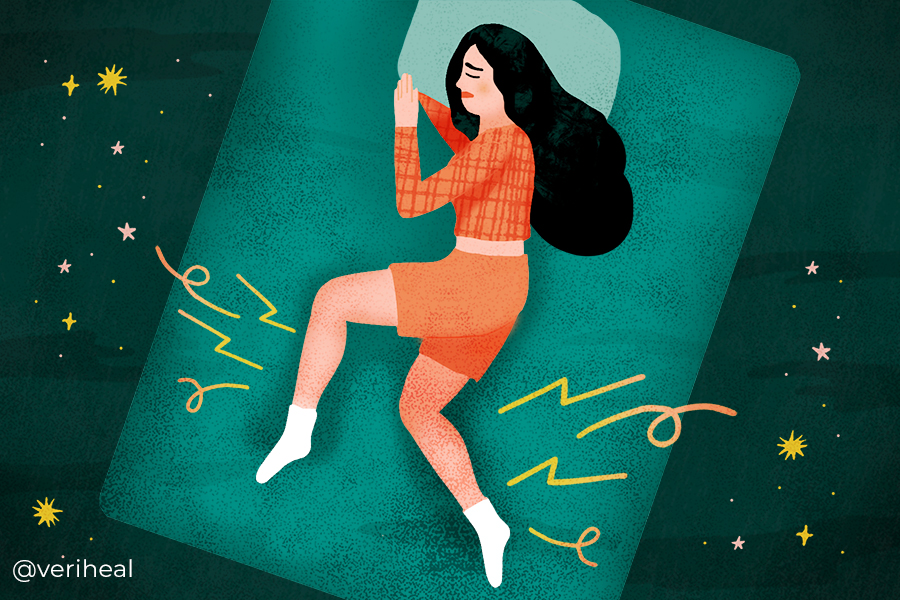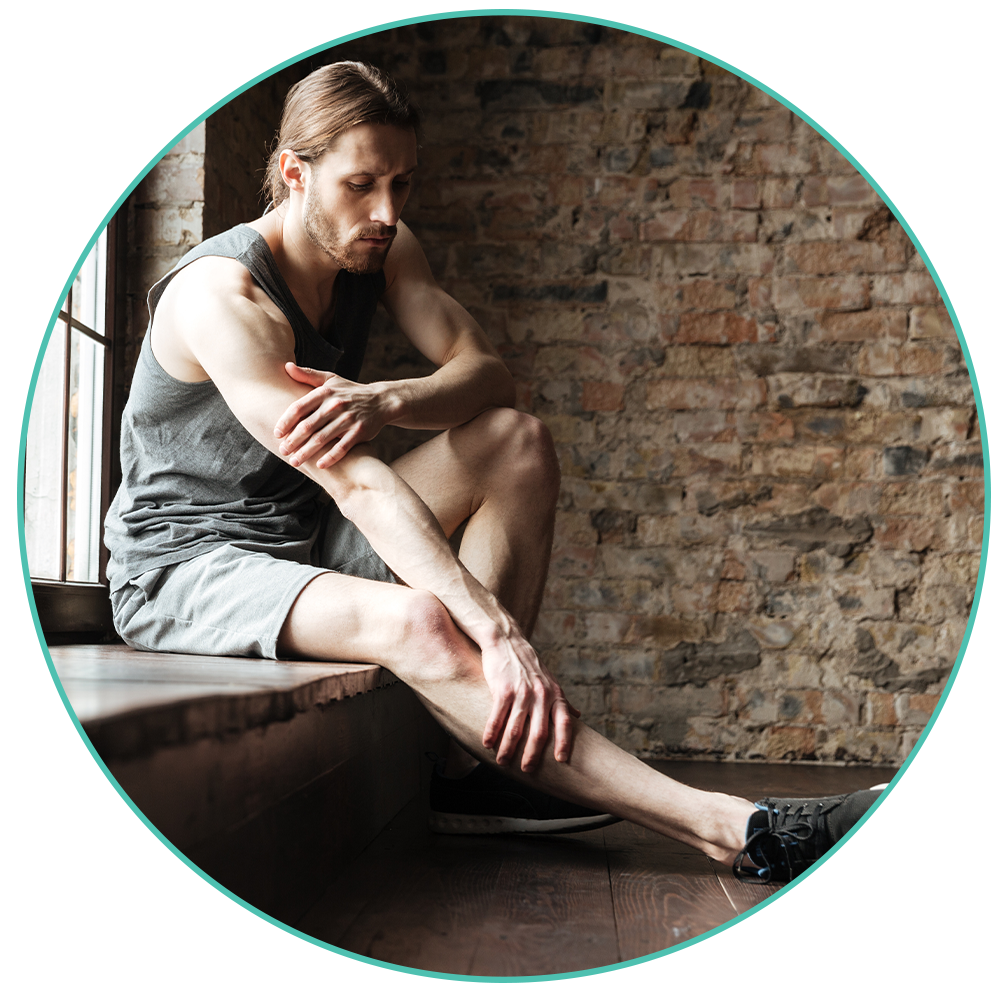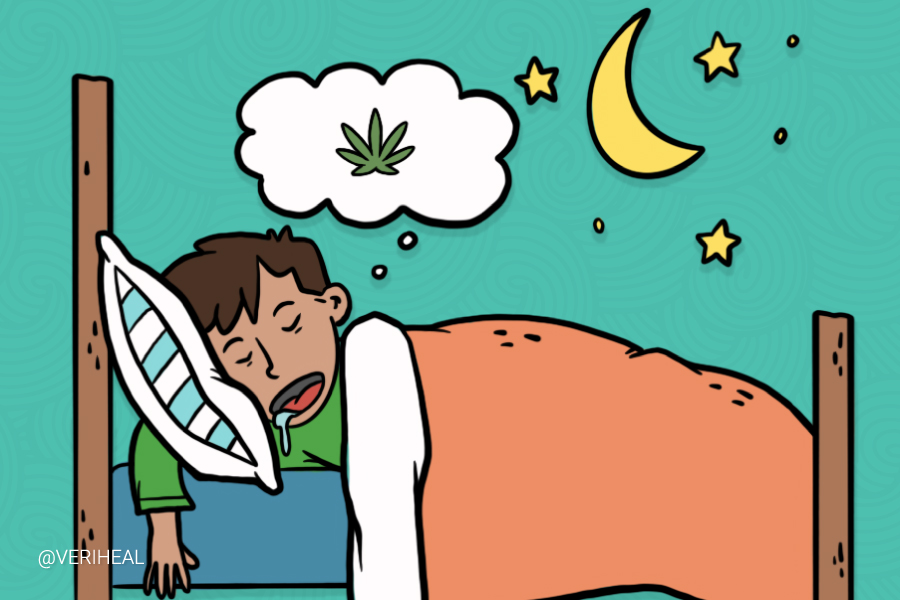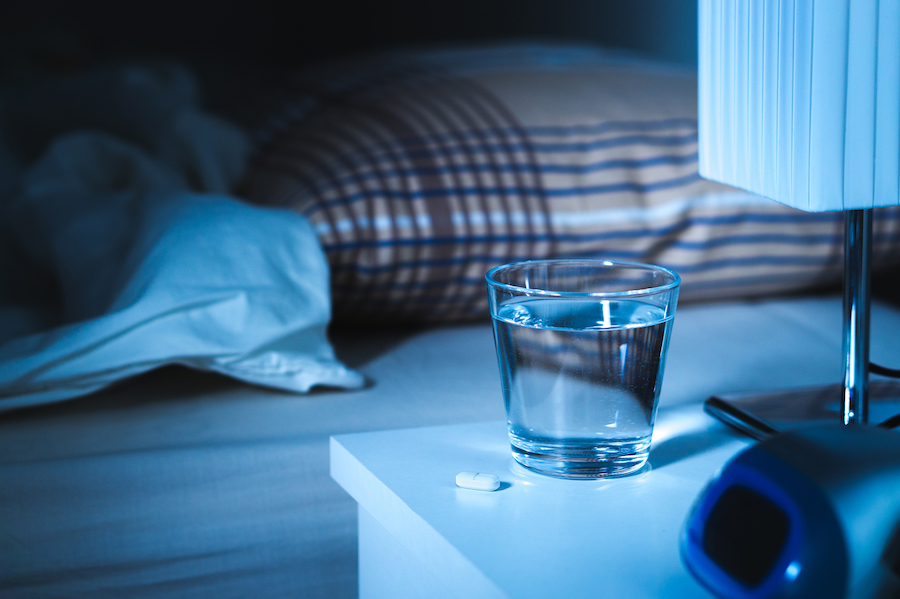Medical Cannabis for Restless Legs Syndrome Treatment

- Medical Cannabis for RLS
- THC and CBD for Restless Leg Syndrome
- Restless Leg Syndrome vs. Periodic Limb Movement Disorder (PLMD)
- Check Out the Research on RLS and Medical Cannabis
Restless Legs Syndrome (RLS), or Willis-Ekbom disease, is a condition where people have an irresistible urge to constantly move their legs because they have strange sensations in their legs that make them uncomfortable. This is especially a problem at night when patients struggle to fall asleep because they have difficulty relaxing to go to sleep. In addition, the legs can move while the patient is sleeping, which causes them to wake up several times throughout the night. Thankfully, many of these patients can use medical cannabis to help them relax, fall asleep, and stay asleep.
Though there are not many clinical trials focusing on cannabis use for patients with RLS—and the fact that RLS is not completely understood—the ability for it to help begins with the activation of the endocannabinoid system (ECS). The ECS consists of fat-based neurotransmitters in the body that are responsible for the body’s perception of pain, maintaining homeostasis and proper body temperature, and modulating the immune system. Research has shown that cannabinoid receptors CB1 can be found in the brain and central nervous system while CB2 receptors are found in the limbs, joints, and other tissues in the body.
Recent research suggests that cannabinoids help RLS through the activation of the CB1 receptors in the brain, specifically in a portion of the cerebellum called the basal ganglia (6)(19). The basal ganglia region is responsible for producing well-controlled and smooth movements. It also contains cells with a high amount of the neurotransmitter dopamine, which researchers believe is linked to movement control.
Researchers believe that patients with RLS release too much dopamine in the basal ganglia. Since the cannabis plant is a dopamine agonist that decreases the amount of dopamine being released in the brain, preliminary research suggests that consuming it restores the basal ganglia to normal dopamine levels, restoring normal neural activity and reducing the symptoms of RLS (8)(19). There may also be some cannabinoid modulation in the dorsal striatum, another area of the brain involved in body movements (6).
For more information on how the endocannabinoid system works, please see our page on endocannabinoids here.
Medical Cannabis for RLS
Patients who take cannabis for RLS may experience the following (20):
- Subjective RLS symptomatic improvement
- Lessening of muscle spasms
- Pain relief
- Mood improvements
- Increased ability to fall asleep and stay asleep
- Improved quality of life
THC and CBD for Restless Legs Syndrome
According to the Restless Legs Syndrome Foundation, dosages for taking cannabis, including Δ9-tetrahydrocannabinol (THC) and cannabidiol (CBD), will vary by the individual due to the fact that everyone metabolizes it differently (2). You do not necessarily need to feel the psychoactive effects to have a therapeutic dose of cannabis. It has been known to cause sleepiness and decrease sleep disruptions, as well as pain-relieving effects that may help ease the symptoms of RLS. In addition, changing doses should be based on the patient’s therapeutic response to medical cannabis.
There are also several medical and non-medical therapies available for helping treat RLS symptoms that you may wish to discuss with your healthcare provider. Some patients find relief from worsening or severe RLS through sleep medications and antidepressants. Taking iron supplements can also help calm the symptoms of Restless Legs Syndrome, even in patients who are not anemic or experiencing an iron deficiency.
Cannabis research focusing on RLS is still in its infancy, so dosages, as well as qualitative scientific data, are still being researched, but anecdotal evidence suggests that patients report relief from symptoms after using cannabis (2).
Restless Legs Syndrome vs. Periodic Limb Movement Disorder (PLMD)
Although RLS and PLMD are both considered sleep disorders and sleep disruptions that involve the limbs, they are very different. But they can easily be confused by patients who are not thoroughly educated about their differences. Read on to learn more.
Restless Legs Syndrome
Patients with RLS have an irresistible urge to move their legs while they are sitting or laying down. It often comes with strange sensations in the legs that are described as burning, creeping, tugging, or bugs crawling in the legs (16). RLS can often be relieved by stretching the legs or walking. It is considered a neurological sleep disorder and a clinical diagnosis, meaning that advanced testing is often not necessary.
Many patients with RLS pace throughout the day, move their legs constantly while they are sitting, and toss and turn in bed. It is difficult to fall asleep or stay asleep because patients have a hard time relaxing because they feel like they constantly must move. In addition, the legs may spontaneously move while the patient is asleep, which often wakes them up (16). RLS is more likely to occur when the patient is under stress and symptoms can come and go over time.
Periodic Limb Movement Disorder
PLMD patients have their arms or legs twitch or jerk every 20 to 40 seconds while they are sleeping, but they often do not know this is happening. The twitching causes patients to wake up briefly and go back to sleep, but unlike RLS, it does not cause abnormal sensations in the limbs. Many of these patients will complain that they sleep poorly, wake up several times a night, or that they feel sleepy during the day (16).
Check Out the Research of RLS and Medical Cannabis
In a 2020 study published in Sleep and Breathing, researchers performed a small-scale clinical analysis of RLS patients who do not get relief from dopamine agonists, opiates, or anticonvulsants that are typically used to treat patients with Restless Leg Syndrome. Eight out of 12 patients reported that they were able to get 100% symptom relief with cannabis. One patient reported 90% RLS symptom relief through using CBD only, while another patient reported 70% symptom relief (6). Only one surveyed patient in that study did not report relief.
Another study surveyed 192 patients with end-stage kidney disease who also had RLS and uremic pruritus (chronic itching due to kidney disease). 14 patients reported cannabis use for these conditions and half of them noted improvement from using cannabis (18). This study confirms that patients with RLS and uremic pruritus are interested in taking cannabis for symptomatic relief.
Though the current RLS data from studies show promising results from using cannabis to tame symptoms, more research is needed to evaluate its objectively measured results using polysomnographic data in larger scale and well-controlled research settings (8).
Note: Veriheal does not intend to give this as professional medical advice. Do not attempt to self-diagnose or prescribe treatment based on the information provided on this page. Always consult a physician before making any decision on the treatment of a medical condition.
1. Babson, K. A., Sottile, J., & Morabito, D. (2017). Cannabis, cannabinoids, and sleep: A review of the literature. Current Psychiatry Reports, 19(4). https://www.med.upenn.edu/cbti/assets/user-content/documents/s11920-017-0775-9.pdf
2. Bainbridge, J., Pharm.D. (n.d.). Understanding Augmentation and Restless Legs Syndrome [PDF]. Restless Leg Syndromes Foundation.https://www.rls.org/file/_2016-redesign/member-publications/webinars/2016/Medical_Marijuana-Bainbridge-Jun2016.pdf
3. Benarroch, E. (2007). Endocannabinoids in basal ganglia circuits: Implications for parkinson disease. Neurology, 69(3), 306-309. https://n.neurology.org/content/69/3/306
4. Bloomfield, M. A., Ashok, A. H., Volkow, N. D., & Howes, O. D. (2016). The effects of Δ9-tetrahydrocannabinol on the dopamine system. Nature, 539(7629), 369–377. https://www.ncbi.nlm.nih.gov/pmc/articles/PMC5123717/
5. Choi, S., Huang, B. C., & Gamaldo, C. E. (2020). Therapeutic Uses of Cannabis on Sleep Disorders and Related Conditions. Journal of clinical neurophysiology : official publication of the American Electroencephalographic Society, 37(1), 39–49. https://pubmed.ncbi.nlm.nih.gov/31895189/
6. Ghorayeb, I. (2019). More evidence of cannabis efficacy in restless legs syndrome. Sleep and Breathing, 24(1), 277-279. http://azmedmj.pharmacy.arizona.edu/sites/default/files/More%20evidence%20of%20cannabis%20efficacy%20in%20restless%20legs%20syndrome%20%281%29.pdf
7. Ghorayeb I. (2021). Cannabis for Restless Legs Syndrome. Advances in experimental medicine and biology, 1297, 173–181. https://pubmed.ncbi.nlm.nih.gov/33537945/
8. Ghorayeb I. (2021) Cannabis for Restless Legs Syndrome. In: Monti J.M., Pandi-Perumal S.R., Murillo-Rodríguez E. (eds) Cannabinoids and Sleep. Advances in Experimental Medicine and Biology, vol 1297. Springer, Cham. https://link.springer.com/chapter/10.1007%2F978-3-030-61663-2_13
9. Home – restless legs syndrome foundation. (n.d.). Retrieved April 09, 2021, from https://www.rls.org/
10. Kaul, M., Zee, P., & Sahni, A. (2021, February 12). Effects of cannabinoids on sleep and their therapeutic potential for sleep disorders. Retrieved April 09, 2021, from https://link.springer.com/article/10.1007%2Fs13311-021-01013-w
11. Kesner, A. J., & Lovinger, D. M. (2020). Cannabinoids, Endocannabinoids and Sleep. Frontiers in molecular neuroscience, 13, 125. https://www.ncbi.nlm.nih.gov/pmc/articles/PMC7388834/
12. Kim, J., Lee, S. L., Kang, I., Song, Y. A., Ma, J., Hong, Y. S., . . . Kim, J. E. (2018). Natural products from single plants as sleep aids: A systematic review. Journal of Medicinal Food, 21(5), 433-444. https://www.liebertpub.com/doi/full/10.1089/jmf.2017.4064
13. Lavoie, J., Illiano, P., Sotnikova, T. D., Gainetdinov, R. R., Beaulieu, J., & Hébert, M. (2014). The Electroretinogram as a biomarker of Central dopamine And serotonin: Potential relevance to psychiatric disorders. Biological Psychiatry, 75(6), 479-486. www.biologicalpsychiatryjournal.com/article/S0006-3223(12)01032-3/fulltext
14. Megelin, T., & Ghorayeb, I. (2017). Cannabis for restless legs Syndrome: A report of six patients. Sleep Medicine, 36, 182-183. https://pubmed.ncbi.nlm.nih.gov/28655453/
15. Mendiguren, A., Aostri, E., & Pineda, J. (2018). Regulation of noradrenergic and serotonergic systems by cannabinoids: Relevance to cannabinoid-induced effects. Life Sciences, 192, 115-127. https://www.sciencedirect.com/science/article/abs/pii/S0024320517306069?via%3Dihub
16. Periodic Limb Movement Disorder (PLMD) and Restless Legs Syndrome (RLS) By Richard J. Schwab, By, Schwab, R., & Last full review/revision Jun 2020| Content last modified Jun 2020. (n.d.). Periodic limb movement Disorder (PLMD) and restless legs Syndrome (rls) – brain, spinal cord, and nerve disorders. Retrieved April 09, 2021, from https://www.merckmanuals.com/home/brain,-spinal-cord,-and-nerve-disorders/sleep-disorders/periodic-limb-movement-disorder-plmd-and-restless-legs-syndrome-rls
17. Restless legs syndrome fact sheet. (n.d.). Retrieved April 09, 2021, from https://www.ninds.nih.gov/Disorders/Patient-Caregiver-Education/Fact-Sheets/Restless-Legs-Syndrome-Fact-Sheet
18. Samaha, D., Kandiah, T., & Zimmerman, D. (2020). Cannabis Use for Restless Legs Syndrome and Uremic Pruritus in patients treated with maintenance dialysis: A Survey. Canadian journal of kidney health and disease, 7, 2054358120954944. https://www.ncbi.nlm.nih.gov/pmc/articles/PMC7488602/
19. Wenk, G., PhD. (2020, July 27). Cannabis for restless leg syndrome. Retrieved August 19, 2021, from https://www.psychologytoday.com/us/blog/your-brain-food/202007/cannabis-restless-leg-syndrome
20. Whiting PF, Wolff RF, Deshpande S, et al. Cannabinoids for Medical Use: A Systematic Review and Meta-analysis. JAMA. 2015;313(24):2456–2473. https://jamanetwork.com/journals/jama/fullarticle/2338251







